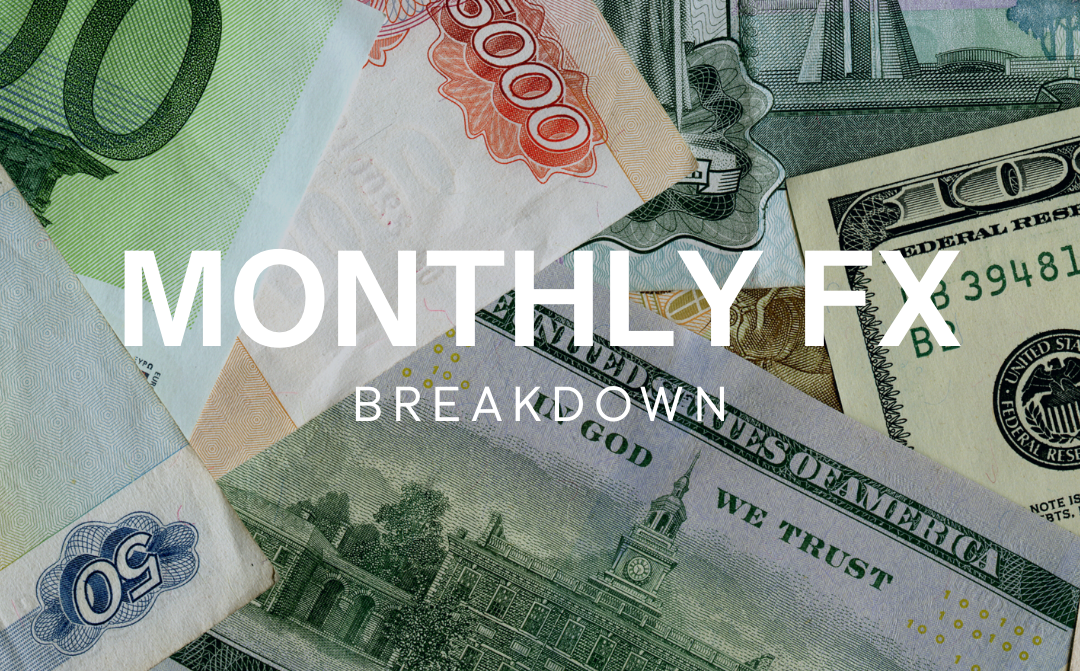Monthly FX breakdown – February 2024

Table of Content
US dollar (USD)
The US dollar enjoyed an impressive start to the year, as wavering expectations around the timing of the first rate cuts brought some caution from financial markets. While we have seen equity indices reach record highs in the US, the relative strength of the dollar does highlight underlying concerns. Particular strength has been seen against the highly pro cyclical Australian dollar and New Zealand dollar, with concerns around the Chinese economy dampening sentiment for those currencies. However we also saw notable dollar gains against the euro and Canadian dollar, particularly through the first two weeks of the month.
The past month saw a significant shift in market expectations around a March rate cut from the Federal Reserve. Kicking off 2024 with markets signalling a 89% expectation that rates would be lowered by the March meeting, the steady easing of those expectations has helped drive the US dollar higher. Part of that comes down to the continued strength of the US economy. The jobs market enjoyed a sharp jump in non-farm payrolls (216k from 173k). Growth came in hot at 3.3% (compared with 2% expected). While retail sales saw the consumer strength continue (0.6% from 0.3%). Set against a backdrop of rising inflation (3.4% from 3.1%), the grounds for such an early rate cut seem to be questionable. Taken alongside wider geopolitical concerns around a potential widening of the Middle East conflict and the possibility of a resurgence in global inflation pressures, it comes as no surprise to see expectations of a March rate cut ease somewhat.
Looking ahead, the dollar looks set to come into focus on 2 February, with the jobs report expected to see the payrolls number fall markedly. Nonetheless, we are yet to see any particular cause for concern as things stand, with a decline to the predicted 175k merely seeing it fall back in line with typical pre-pandemic levels. Instead, it will be the inflation figure on the 13th which could really spark major volatility, with a sharp decline needed to push that narrative of a potential rate cut on 20 March. We are likely to see CPI head lower, but whether it is enough to lift expectations of a March cut remains to be seen. The month ends with another key inflation reading, with the core PCE price index providing the one significant justification for a swift pivot from the Federal Reserve. With the Fed’s favoured inflation metric tracking at a pace consistent with the 2% target over the past six-months, another monthly figure of 0.2% or below could weaken the dollar. Nonetheless, the ongoing strength of the US economy and slow pathway back to target for inflation do highlight the potential for further dollar upside as rate cut expectations ease.
Euro (EUR)
January was a tale of two halves for the euro, with a relatively strong first fornight giving way to a weak end to the month. That pattern largely took place against the likes of the Canadian dollar, Australian dollar, and New Zealand dollar, as early gains eased back towards the end of the month. Unfortunately, things were less favourable elsewhere, with EURUSD and EURGBP both trading heavily over the course of the month.
The month kicked off with a focus on the eurozone inflation picture, with headline CPI rising to 2.9% (2.4%). This was actually below expectations, and we are likely to see this rate fall back in the coming months. We have seen a similar picture from the core CPI rate, which looks likely to head sharply lower from March onwards despite remaining well above target at 3.4%. From an economic perspective, the latest PMI data brought mixed signals, as improved manufacturing figures were counteracted by declines in the services sector figure. In any case, both remain well in contraction territory. Despite this, we saw a welcome surprise as the fourth quarter GDP figure came in flat at 0%, averting a widely anticipated recession for the region following the -0.1% Q3 figure. While ECB members spent much of the month seeking to play down expectations of an impending rate cut, although there are clearly many that do not believe the committee will ultimately hold off for very long given the weak economic outlook and prospect of a swift return to target for inflation in the coming months.
Looking ahead, February kicks off with a focus on eurozone inflation, with lower than expected French and German figures bringing expectations of a similar move for the wider regional figure. Nonetheless, it looks likely that we will see CPI remain somewhat elevated for the time being, with the disinflation only really kicking in once we see the February figure drop out in a month’s time. With inflation likely to remain elevated this month and the economic picture unlikely to improve to the extent that markets perceive an ECB cut as being unnecessary, it is likely to be a month of trying to second guess the continued cautious approach from the ECB. Market pricing for the March meeting remains geared towards a hold for now (73%), and thus any signs that the ECB are willing to open up to the idea of a rate cut at that meeting could drive EUR lower. Otherwise, we could see continued indecision that makes for further directional inconsistency going forward.
British pound (GBP)
The pound has enjoyed a strong start to 2024 with the currency enjoying plenty of upside over the first three weeks of the month in particular. While those early gains faded somewhat towards the end of the month, the relatively strong economic picture in the UK has provided the backdrop for a positive period. The most notable gains have come against the antipodeans (AUD and NZD), but we have also seen significant gains against the euro and Canadian dollar.
From an economic perspective, January saw markets realise the relative strength of the UK thanks to an impressive November GDP figure of 0.3%. The reliance of the UK on the services sector has provided a backstop against some of the economic weakness seen elsewhere, with the 53.8 services PMI reading helping to drive the wider composite figure into a seven-month high of 52.5. With both headline (4%) and core ((5.1%) inflation remaining worryingly high, the strength of the economy does highlight grounds for Sterling strength as the Bank of England look to maintain rates in a bid to drive inflation pressures lower.
Looking ahead, February kicks off with the latest Bank of England decision, as Governor Andrew Bailey looks to temper expectations of a dovish pivot. Market pricing shows a 52% chance that we see the first rate cut in May, and thus any shift in those expectations will be key in driving GBP sentiment. The January inflation report (14 February) could provide a curveball given the potential rise that could further strengthen the pound. Nonetheless, we expect to see UK inflation fall sharply in the months beyond as the hefty monthly figures from February (1.1%), March (0.8%), and April (1.2%) 2023 fall out of the yearly CPI metric. As such, further sterling strength does look likely as we move through the month, although the underlying metrics point towards a shift in tone from March onwards.
Canadian dollar (CAD)
2024 has started off with a bang for the Canadian dollar as the currency enjoyed plenty of gains despite initial question marks around prices within their key oil and gas export markets. Much of that upside came fellow commodity currencies, with the Australian dollar and New Zealand dollar both down heavily against the Loonie. We saw a somewhat less convincing story elsewhere though, with the currency losing ground against The US dollar and British pound.
From an economic perspective January saw the Canadian economy flash mixed signals. The jobs market brought a concerningly low employment change reading of 0.1K, the lowest figure in five months. Meanwhile we also saw cause for concern around the Canadian retail sales figures, which saw both core (-0.5%) and headline (-0.2%) retail sales contract in November. Nonetheless, a rebound in both the wide reaching Ivey PMI indicator (56.3), and headline CPI (3.4% from 3.1%) brought expectations of a cautious Bank of Canada. Nonetheless, it is notable that the monthly figure did see a sharp decline, raising hopes the price pressures are easing further. The Bank kept rates steady as expected, noting that they do not see inflation returning to target until 2025 given that “core measures of inflation are not showing sustained declines.” With crude oil pushing higher on growing concerns of a wider middle east conflict, and falling US inventories, we have seen the Canadian dollar come into favour over recent weeks.
Looking ahead, February kicks off with the OPEC meeting on the first day of the month. With Saudi Arabia already pulling back on their pledge to increase production by 1M barrels per day, energy prices will likely see volatility in the event of any signal that the group is seeking to ramp up efforts to strengthen oil prices. Keep a close eye out for the Ivey PMI (6th), as continued strength provides the Bank of Canada with further room to maintain rates at their current levels in a bid to drive down inflation. The Canadian inflation report comes on 20 February, with a decline in headline inflation looking likely as the last year’s 0.5% monthly reading is stripped out.
Australian dollar (AUD)
The Australian dollar suffered heavy losses over the course of the month, although this key commodity currency did manage to stabilise in the final week of January. With the Aussie dollar losing ground against the NZD, this currency represents the worst performing of the six mentioned here. The US dollar and British pound provided the two most notable counterparts, with both GBPAUD and AUDUSD moving over 3% against the Aussie dollar.
Concerns for the Chinese economy provided the backdrop for much of the weakness seen over the course of January, with the key trading partner remaining in a state of deflation (-0.3%). Chinese GDP fell short of expectations at 5.2% while the manufacturing sector remains in contraction territory according to the latest 49.2 PMI reading. In terms of the Australian outlook, recent declines in CPI inflation heighten calls for a swifter return to easing than some had expected. The relatively infrequent nature of Australian inflation announcements means that this quarterly report held greater importance. With retail sales falling-2.7% and Australian employment collapsing by the greatest amount in over two-years (-65.1K), the Q4 CPI reading of 0.6% does raise hopes of a dovish turn from the Reserve Bank of Australia.
Markets are currently pricing a 61% chance that the RBA cut rates in June, and the forthcoming month should help to further shape those expectations. With China seeking to limit the fallout of the recent Evergrande liquidation announcement, any further signs of weakness across the Chinese or Australian economy could help drive AUD lower yet. Keep an eye out for any greater clarity on the timing of that first cut when we see the RBA meet on 6 February. Meanwhile, the jobs report will provide an area of particular focus given the collapse in the employment change figure last time around. Finally, the annual inflation rate reported on 27 February looks to provide a volatile end to the month for the Australian dollar.
New Zealand dollar (NZD)
The Kiwi dollar similarly suffered sharp losses over the course of January, with the strong correlation between the two antipodean currencies ensuring weakness carried across to NZD. Similarly, we saw the pound and US dollar outperform, although the final week of the month did bring a fight back from the Kiwi dollar. Elsewhere, the Australian dollar did provide the one area of success for this currency, with AUDNZD closing out in the red despite wide swings over the course of January.
From an economic perspective, January saw Chinese concerns dominate, with the strength of this key trading partner a concern once again. We did see commodity prices improve in December according to the latest ANZ commodity price index reading of 2.4%. That figure was remarkably similar to the global dairy prices reading of 2.3%. Nonetheless, a sharp decline in Chinese retail sales does highlight a weak consumption environment that could impact New Zealand exports. January also brought a surprise jump in New Zealand unemployment, with the 0.3% rise to 3.9% bringing about concerns that the interest rate environment is finally having a damaging effect on the economy. With China in trouble, markets have largely looked through the elevated inflation rate to bring expectations of a dovish pivot from the Reserve Bank of New Zealand. However, the NZD did strengthen towards the end of the month after the RBNZ Chief Economist Paul Conway warned that the bank needed to remain patient in a bid to drive down inflation from current levels.
Looking ahead, watch out for any fresh signs of stimulus from China, with the recent signals pointing towards a more active approach from the government and PBoC. The New Zealand jobs report provides a key event to follow given the recent rise to 3.9%. Another bump in unemployment could put pressure on the RBNZ to pivot earlier than currently planned. The month ends with the RBNZ interest rate decision, which is an opportunity to gauge the outlook for rates, with the bank likely to maintain a patient and steadfast approach for the time being.
Disclaimer: This material is a marketing communication and shall not in any case be construed as an investment advice, investment recommendation or presentation of an investment strategy. The marketing communication is prepared without taking into consideration the individual investors personal circumstances, investment experience or current financial situation. Any information contained therein in regardsto past performance or future forecasts does not constitute a reliable indicator of future performance, as circumstances may change over time. Scope Markets shall not accept any responsibility for any losses of investors due to the use and the content of the abovementioned information. Please note that forex trading and trading in other leveraged products involves a significant level of risk and is not suitable for all investors.







